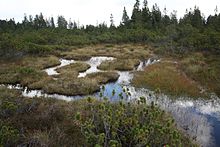Small crane lake

The Little Crane Lake (Czech: Malé jeřábí jezero ) is one of the most important high moors in the Ore Mountains . In Saxony, the moor has been under nature protection since 1939. Today it is the main component of the larger NSG Kleiner Kranichsee, Butterwegmoor and Henneberger Hang . The Czech part of the bog was placed under state protection as a nature reserve on 6.02 hectares in 1962 .
location
The high moor is located at an altitude of 930 meters above sea level. NN in a clearing in the high forest southwest of Johanngeorgenstadt . The border between Germany and the Czech Republic runs through the high moor and continues over the Buchschachtelberg to Jugel .
Surname
The name of the raised bog is associated with the Slavic word granica for border. With seihe , see , moor areas used to be referred to, so that the name means "Grenzmoor". The Kleine Kranichsee was first mentioned in a document in 1551.
history
To the east of the Kleiner Kranichsee in the direction of the Henneberger Häuser peat was extracted until 1923 and parts of the raised bog were removed as a result. The NW-SE striking iron ore vein Sechs-Brüder-Einigkeit-Flache runs underground , which was developed in the raised bog itself and in the immediate vicinity through the sea shaft, the Michaelis shaft and the Sechs-Brüder-Einigkeit-Fundgrube. Remnants of the dump can still be seen today on the edge of the raised bog. Tin was mined not far from the Henneberg houses .
In 1939 the Kleiner Kranichsee was placed under protection by ordinance of the Reich Governor of Saxony, Martin Mutschmann . The protected area comprised 13.75 hectares of the central moor area with the Bult-Schlenken complex . In 1961 the nature reserve was expanded to 29.15 hectares. In the following year, a 6.02 hectare nature reserve was created on Czechoslovakian territory immediately behind the border.
meaning
It is a watershed and Krummholzhochmoor , which is drained to the north by the Steinbach , to the west by the Große Bockau , to the south by the Buchschachtelgraben and to the east by the Lehmergrundbach. To the west there is the Großer Kranichsee , whose bog core is on the Czech side.
vegetation
- Mountain pine ( Pinus mugo )
- Vaginal cottongrass ( Eriophorum vaginatum )
- Black crowberry ( Empetrum nigrum )
- Bogberry ( Vaccinium uliginosum )
- Rosemary heather ( Andromeda polifolia )
fauna
- Adder ( Vipera berus )
- Mountain Lizard ( Lacerta vivipara )
tourism
Already at the turn of the century, the Erzgebirgszweigverein Johanngeorgenstadt dug a stick dam in the moor and erected a viewing scaffold with a protective roof, which has since been renewed several times and whose location was relocated several meters in the 1970s to better protect nature.
literature
- Small crane lake. In: Um Aue, Schwarzenberg and Johanngeorgenstadt (= values of our homeland . Volume 20). 1st edition. Akademie Verlag, Berlin 1972, pp. 190–194.
- Adolf Hanle: Small crane lake . In: Erzgebirge (= Meyer's nature guide ). Meyers Lexikonverlag, Mannheim a. a. 1992, p. 81 f .
- Eduard Wagner: The dying lake. In: Erzgebirgs-Zeitung , 52nd year, 1931, pp. 2–7. ( Digitized version )
- District of the Erzgebirgskreis: Conservation-related appreciation for the "Kleiner Kranichsee, Butterwegmoor and Henneberger Hang" nature reserve in the Erzgebirgskreis , Annaberg 2011, 20 digital pages
Coordinates: 50 ° 25 ′ 4 ″ N , 12 ° 40 ′ 27 ″ E
